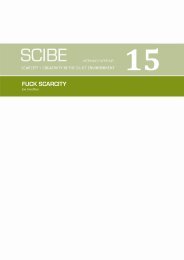Urban Scarcities: A Look at Shanghai - SCIBE
Urban Scarcities: A Look at Shanghai - SCIBE
Urban Scarcities: A Look at Shanghai - SCIBE
You also want an ePaper? Increase the reach of your titles
YUMPU automatically turns print PDFs into web optimized ePapers that Google loves.
20<br />
Deljana Iossifova<br />
Cre<strong>at</strong>ive Cities<br />
The ‘planned city can identify, accommod<strong>at</strong>e, and enable the kind of organic<br />
growth th<strong>at</strong> feeds innov<strong>at</strong>ion and inspir<strong>at</strong>ion’, and th<strong>at</strong> ‘cre<strong>at</strong>ive innov<strong>at</strong>ion’<br />
is something designed into ‘the vision of the master plan’, following the<br />
example of ‘existing cities such as Paris, New York, and Venice’, some<br />
argue 25 . Others claim th<strong>at</strong> comb<strong>at</strong>ing ghettos and slums—the ‘homogeneous<br />
spaces th<strong>at</strong> have a high concentr<strong>at</strong>ion of people and a low socio-economic<br />
st<strong>at</strong>us’ will cre<strong>at</strong>e more problems than solutions in the long run 26 ; they see<br />
squ<strong>at</strong>ter cities as the ‘labor<strong>at</strong>ories for innov<strong>at</strong>ion and adapt<strong>at</strong>ion’, and claim<br />
th<strong>at</strong> ‘architects must be agents of active change and advoc<strong>at</strong>es for the users<br />
of their designs’ 27 . In this paper, I have tried to show on the example of<br />
<strong>Shanghai</strong> th<strong>at</strong> the city is a system which contains both, ‘formal’ and<br />
‘informal’, and th<strong>at</strong> these elements are already inherently linked to each<br />
other. If we want to understand how scarcities are gener<strong>at</strong>ed, constructed,<br />
and perceived in the context of the built environment, it is necessary to look<br />
<strong>at</strong> the city as a system which spans across a multitude of scales and<br />
agencies. Cre<strong>at</strong>ive reaction and adapt<strong>at</strong>ion to real or perceived scarcities,<br />
then, happen on different scales and influence each other, and cre<strong>at</strong>ivity can<br />
no longer be thought as a property exclusive to the designer. In the words of<br />
Swyngedouw and Kaika: ‘Not only considerable urbanistic and architectural<br />
cre<strong>at</strong>ivity needs to be mobilised, but also a reconsider<strong>at</strong>ion of the meaning<br />
of urban citizenship in terms of a multitude of identities constructed<br />
through myriad of sp<strong>at</strong>ially overlapping rel<strong>at</strong>ions and networks’ 28 .<br />
25<br />
Stan Gale and Alfredo Brillembourg, ‘The Deb<strong>at</strong>e Zone: As the World <strong>Urban</strong>izes, Will the Most<br />
Successful Cities Result from Top-down Planning or Bottom-up Innov<strong>at</strong>ion?’, Wh<strong>at</strong> M<strong>at</strong>ters<br />
<br />
[accessed 2<br />
February 2011].<br />
26<br />
Sandro C<strong>at</strong>tacin, ‘Why Not "Ghettos"? The Governance of Migr<strong>at</strong>ion in the Splintering City’<br />
.<br />
27<br />
Gale and Brillembourg.<br />
28<br />
Erik Swyngedouw and Maria Kaika, ‘The Making of 'glocal' <strong>Urban</strong> Modernities’, City, 7 (2003),<br />
5-21 .




